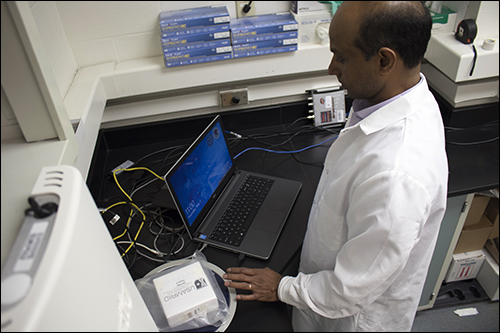When some of the most sensitive biological samples are stored in laboratories, even removing them from freezers for a minute could increase their temperature. That means the manual process of inventory counting could pose a risk to the samples themselves. Therefore, the U.S. Army Medical Research Institute of Infectious Diseases (USAMRIID) has spent the last two years testing an RFID-based solution that may enable it to count its highly sensitive samples without removing them from freezers. The agency is presently testing UHF RFID tags and readers at its lab in Fort Detrick, Md.
USAMRIID (pronounced “you-SAM-rid”) conducts research on developing medical countermeasures against biological threats aimed at U.S. troops. It employs military and civilian scientists and collaborates with the Centers for Disease Control and Prevention, the World Health Organization, and multiple biomedical and academic institutes around the world. Part of the work being conducted at the Biosafety Level 3 and Level 4 laboratories involves the development of medical solutions, such as vaccines and drugs, as well as research on Biological Select Agents and Toxins (BSAT) samples.

The lab tracks all BSAT in storage by performing physical inventory counts. “We have to be 100 percent accountable for those samples,” says Md Mizanur Rahman, a microbiologist in USAMRIID’s Select Agent Management Division, who leads the RFID research team. Rahman presented the lab’s testing experiences at last month’s RFID Journal LIVE! conference (see Enhancing Security of Concealed Biological Specimens With RFID), held in Phoenix, Ariz.
Inventory management has traditionally meant that individuals inspect and document samples one at a time, typically removing them from cold storage to visually confirm each sample’s identity and then returning it to the freezer. Such manual counting is time-consuming and error-prone, while also posing a risk to the samples’ integrity.
In general, these materials must be stored at temperatures of -80 degrees Celsius (-112 degrees Fahrenheit) or colder. “When they are removed from the freezers, the samples can get degraded as soon as the temperature starts to rise,” Rahman explains. So in addition to accountability, he says, the lab strives to maintain the integrity of the biological sample as well.
The lab’s goal is to track all of its BSAT samples via RFID. The research has been focused on testing hardware components, including numerous UHF tags and handheld readers. The tags need to be read with 100 percent accuracy, and the team is investigating whether they could potentially be scanned without freezers having to be opened. If the tags could transmit through a freezer, Rahman notes, sample inventory counts could be performed more easily and rapidly.
Instead of having the samples manually counted, Rahman says, USAMRIID seeks a system that would enable hundreds of samples to be read simultaneously. Experiments so far have included tags provided by multiple companies, including Avery Dennison and Tageos. Those tags have been read via handheld and fixed readers.
In addition, because many samples are composed of liquid or are stored in an environment surrounded by metal, the research team has been testing which tags are the most effective in such scenarios. They read the tags every month to determine whether tag sensitivity degrades over time in a very cold environment. “We’ve got some interesting results after one year of testing,” Rahman states.
“We can’t go below a 100 percent read rate, so testing every option is very important,” Rahman explains. “We would also like to test RFID technology to track the BSAT samples being shipped out from the institute.” If the receiving entities also start using this technology, he adds, the system will be able to identify what is being received as well. “Once we can implement this technology in our institute, we’d like to discuss, with responsible personnel in other facilities, the potential benefits of using this system to maintain their own inventory.”
The researchers have not tested any temperature-sensing RFID tags. However, the team is currently considering the option of linking RFID data for each freezer with temperature data from a separate sensor system. If the RFID solution works as planned, Rahman says, it could significantly decrease the amount of time required to perform inventory counts, as well as eliminate manual counting, maintain sample integrity and reduce the incidence of human error. The long-term goal is to tag all of the samples, amounting to thousands of tags.

